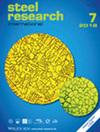炼钢转变过程及其对炉渣利用的影响
IF 1.9
3区 材料科学
Q2 METALLURGY & METALLURGICAL ENGINEERING
引用次数: 0
摘要
未来十年,欧洲钢铁工业面临的主要挑战是钢铁生产转型过程。许多钢铁生产商的目标是,用气体直接还原铁(DRI)工艺结合电炉冶炼工艺,取代二氧化碳密集型高炉/碱性氧气炉工艺,从而避免二氧化碳排放。因此,众所周知的水力造粒高炉渣(GBS)将逐步消失。140 多年来,由于矿渣具有减少熟料的潜力,因此在水泥和混凝土生产中具有减少二氧化碳排放的潜力,一直被用作水泥基辅材料。此外,矿渣水泥还具有一些特殊的技术优势。固态 DRI 工艺本身不会产生炉渣,而不同的电炉冶炼工艺则会分别产生液态钢或 "电 "生铁,同时产生不同类型的炉渣。然而,新炉渣的具体炉渣/金属比例、产生的炉渣量、化学和矿物成分以及物理性质尚不清楚。因此,它们的胶凝特性和环境特性也仍然未知。目前正在进行和计划进行的不同项目的主要目的是使不同类型的新炉渣能够替代 GBS,以继续钢铁和水泥行业之间成功的跨行业合作。本文章由计算机程序翻译,如有差异,请以英文原文为准。
The Steelmaking Transformation Process and Its Consequences for Slag Utilization
The main challenge of the European steel industry for the next decade is the steel production transformation process. Many steel producers aim to avoid their CO2 emissions by substituting the CO2 ‐intensive blast furnace/basic oxygen furnace route by a gas‐based direct reduced iron (DRI) process combined with an electric smelting process. Thus, the well‐known latent hydraulic granulated blast furnace slag (GBS) will vanish step by step. For more than 140 years, this slag has been used as a supplementary cementitious material due to its clinker reduction potential and from there its CO2 reduction potential for the cement and concrete production. Moreover, slag cements offer some special technical advantages. Whereas the solid‐state DRI process itself does not generate any slag, the different electric smelting processes will produce liquid steel or “electric” pig iron, respectively, together with very different types of slags. However, specific slag/metal ratios, resulting slag volumes, chemical and mineralogical composition, and physical properties of the new slags are yet unknown. Therefore, their cementitious and environmental properties are also still unknown. Different current and scheduled projects aim mainly to enable the different types of new slags to substitute GBS to continue the successful cross‐industrial cooperation between steel and cement industry.
求助全文
通过发布文献求助,成功后即可免费获取论文全文。
去求助
来源期刊

steel research international
工程技术-冶金工程
CiteScore
3.30
自引率
18.20%
发文量
319
审稿时长
1.9 months
期刊介绍:
steel research international is a journal providing a forum for the publication of high-quality manuscripts in areas ranging from process metallurgy and metal forming to materials engineering as well as process control and testing. The emphasis is on steel and on materials involved in steelmaking and the processing of steel, such as refractories and slags.
steel research international welcomes manuscripts describing basic scientific research as well as industrial research. The journal received a further increased, record-high Impact Factor of 1.522 (2018 Journal Impact Factor, Journal Citation Reports (Clarivate Analytics, 2019)).
The journal was formerly well known as "Archiv für das Eisenhüttenwesen" and "steel research"; with effect from January 1, 2006, the former "Scandinavian Journal of Metallurgy" merged with Steel Research International.
Hot Topics:
-Steels for Automotive Applications
-High-strength Steels
-Sustainable steelmaking
-Interstitially Alloyed Steels
-Electromagnetic Processing of Metals
-High Speed Forming
 求助内容:
求助内容: 应助结果提醒方式:
应助结果提醒方式:


